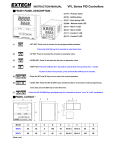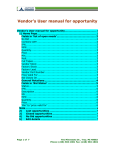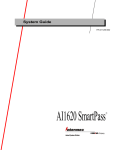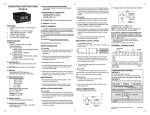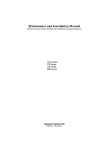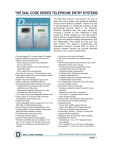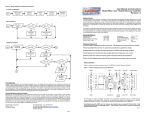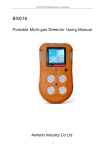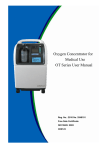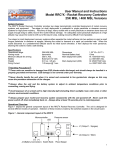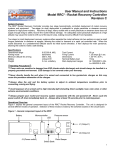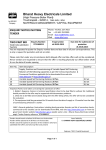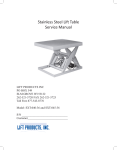Download M210_01 Operator
Transcript
Operator Manual Tempress® Systems, Inc. Operator manual M210_01 January 2004 This page intentionally left blank TABLE OF CONTENTS Table of contents Preface .....................................................................................III Tempress documentation set................................................................ III User Definition ...................................................................................... IV Notes, Cautions and Warnings .............................................................. V Contents description ............................................................................. VI Revision History .................................................................................... VI 1. Introduction .......................................................................1-1 1.1 General ..................................................................................... 1-1 1.2 Operator area description ......................................................... 1-2 2. Safety .................................................................................2-2 2.1 Emergency Off (EMO) .............................................................. 2-2 2.2 Alarm Signals............................................................................ 2-2 2.2.1 Buzzer / LED ............................................................. 2-2 2.2.2 Touchscreen.............................................................. 2-2 2.2.3 Light tower ................................................................. 2-3 2.2.4 TSC Alarm menu ....................................................... 2-3 2.3 Light tower signal description (optional).................................... 2-3 2.4 Toxic Material ........................................................................... 2-5 2.5 Safety measures ....................................................................... 2-5 3. Operator Instructions.....................................................2.5-1 3.1 3.2 Load or Unload process wafers ............................................. 3.1-1 3.1.1 Load process wafers............................................... 3.1-1 3.1.2 Unload wafers......................................................... 3.1-1 Selecting a new process recipe ............................................. 3.2-1 3.2.1 Touchscreen........................................................... 3.2-1 3.2.2 TSC-2 ..................................................................... 3.2-3 OPERATOR MANUAL I TABLE OF CONTENTS 3.3 3.4 3.5 3.6 Start/Continue a new process recipe ..................................... 3.3-1 3.3.1 Touchscreen........................................................... 3.3-1 3.3.2 TSC-2 ..................................................................... 3.3-2 Stop a running process recipe ............................................... 3.4-1 3.4.1 Touchscreen........................................................... 3.4-1 3.4.2 TSC-2 ..................................................................... 3.4-2 Abort a running process recipe .............................................. 3.5-1 3.5.1 Touchscreen........................................................... 3.5-1 3.5.2 TSC-2 ..................................................................... 3.5-2 Clear Alarms .......................................................................... 3.6-1 3.6.1 Required action....................................................... 3.6-1 3.6.2 Touchscreen........................................................... 3.6-1 3.6.3 TSC-2 ..................................................................... 3.6-2 OPERATOR MANUAL II PREFACE Preface This set of manuals explains how to operate a Horizontal Diffusion/LPCVD furnace. Refer to the Touchscreen reference manual (M440.01) or the TSC-2 reference manual (M450.03) for a full description of all operating screens. For information about processing refer to the Process Manual (M220.xxx.02). The Tempress Horizontal Diffusion Furnaces are fully described in the reference manuals (M300 series). Tempress documentation set The complete Tempress documentation set includes: • Safety manual • Operator manual • Reference manuals 1. Loadstation 2. Furnace 3. Gas cabinet 4. Main Power cabinet 5. DPC 6. DTC 7. Touchscreen 8. TSC-2 (+ optional SECS/GEM) • Vendor documentation Delivery’s on request: • Desired vendor documentation • Sic and Quartz drawings • RS422 protocol (DPC/DTC) OPERATOR MANUAL III PREFACE User Definition It is strongly recommended that all users first read this manual before starting any procedure. To produce an accessible manual suiting on various responsibilities, Tempress defines the following users: Operator The operator is handling the process from loading until unloading of the wafers. Therefore the operator needs to select a recipe, put the wafers on the boat, fill in Lot ID, Start the process, monitor the progress and unload wafers. Process engineer The process engineer is a qualified chemical engineer, who is responsible for the process recipes and their results. The process engineer writes, tests and releases new process recipes. Service or Maintenance engineer The maintenance engineer is a qualified electrician or mechanic, who is responsible for a proper functioning system in accordance to its designated purpose. A Tempress qualified service engineer will perform the first installation. OPERATOR MANUAL IV PREFACE Notes, Cautions and Warnings Notes, Cautions and Warnings appear throughout this manual, where extra attention is required to a particular (safety) item. Three levels can be distinguished: NOTE ) Notes alert to pay attention to items or procedures of special importance. CAUTION Cautions alert for a potentially hazardous situation that may result in minor or moderate injuries. Cautions can also alert for potential equipment and/or product damage. WARNING Warnings alert for conditions that may result in permanent and/or lethal injuries. OPERATOR MANUAL V PREFACE Contents description This manual is divided into the following sections and appendices: Section 1 Introduction Provides an overview of the Tempress Systems Inc. Horizontal furnace. Section 2 Safety Describes the safety components and functions. It describes all measures that are required to provide a safe way of working. Section 3 Operator Instructions Describes all procedures that are required for the operator. Revision History This manual is revision 1 of the Operator Manual and is intended to explain the required operator procedures. The function and screens it describes are based on the following software releases: • TSC 2 version 6.3 (17-02-2003) • DPC 2.I.03 (17-02-2003) • DTC 2.F.02 (17-02-2003) • Touchscreen 2.I.05 (17-02-2003) For minor software and hardware changes, addendum to this manual will be available. For major changes, a new revision will be available. For information or other questions please contact Tempress Systems Inc. OPERATOR MANUAL VI INTRODUCTION 1.Introduction 1.1 General The horizontal furnaces of Tempress Systems Inc. are developed according to the European directives for Machinery (98/37/EC), Low Voltage (73/23/EC) and EMC (89/336/EEC). The Tempress Diffusion system is a modular horizontal furnace designed to process (silicon) wafers as part of the manufacturing technology of semiconductor, optical, MEMS and solar devices. Figure 1-1 shows an example of a standard L-shape diffusion system with 4 process tubes shown without the partition of a cleanroom wall. It is a right-handed system, defined according to the position of the furnace relative to an operator. Usually the system contains more than 1 tube. Based on the number and size of tubes, the system is referred to as a 2, 3 or 4 stack. Figure 1-1 is an example of a 4-stack system, allowing up to 4 different processes at any time. The tubes are numbered from 1 to 4, with tube number 1 at the top and tube 4 at the bottom. All tubes operate fully independently. Main Power Cabinet Figure 1-1 Schematic view of a right-handed 4-stack Diffusion System OPERATOR MANUAL 1-1 INTRODUCTION 1.2 Operator area description HOT SURFACE Buzzer/LED Light/Fan Switch Touchscreen EMO Wafers MOVING PART Figure 1-2 Loadstation The operator area is limited to the loadstation only. Figure 1-2 shows the relevant items. The Loadstation part of a Tempress System should be placed in the cleanroom. The Furnace and Gas cabinet can optionally be placed in the greyroom. To load wafers, several loader types can be implemented, including the (default) inline loader, the Amtech Atmoscan®, and the backmounted softlander. To prevent particles on the wafers during the loading process, a constant horizontal laminar flow is created from the loadstation into the cleanroom. The loadstation is powered by 220V and has an illuminated On/Off switch for the fans and the lights. The remote control cabinet in the loadstation contains TFT-Touchscreens, one for each tube. These supply the user interface for communication with the Digital System Controllers (Digital Process Controller, Digital Temperature Controller and Digital Motion Controller). OPERATOR MANUAL 1-2 SAFETY 2.Safety This section contains a brief description of the safety features of a Tempress Horizontal Diffusion System for the operator. Operators must have a general knowledge of the technology involved in diffusion systems. They should understand safety practices outlined in this manual. The descriptions contained in this user manual are general in nature or generic. The actual furnace may differ in minor detail from the furnace described in this manual, because of customer specific requirements or modifications. Please refer to the Tempress Safety manual for a complete description of available safety features. 2.1 Emergency Off (EMO) Emergency Off (EMO) buttons are located around the system at accessible locations according to EN 60204-1, especially EN 418. Pressing an EMO button turns off all power to the system except to the fans on top of the furnace. This prevents fire hazard as a result of high heat concentration in the furnace cabinet. Also those parts that are connected to a UPS facility remain operational. Press the EMO button when a person is in danger, when there is a fire, a water leak or any other event that could be hazardous to life. 2.2 Alarm Signals Alarms and alerts generated by tube controls are presented in several ways: • Buzzer / LED • Touch screen • Light tower • TSC-II 2.2.1 Buzzer / LED Visible and audible alarm signals are generated by the DPC, DTC and the DMC. The visible signals will be presented with a LED, located below the buzzer position as shown in Figure 1-1. Each tube process is represented by one LED and buzzer combination. 2.2.2 Touchscreen The visible alarm signals will be presented on the touchscreen bottom line. Alarms on the Touchscreen are always in combination with an audible signal. Touching the screen deactivates the audible signal. A new Alarm or alert will not activate the audible signal again before current alarm has been solved. OPERATOR MANUAL 2-2 SAFETY 2.2.3 Light tower Alarms generated by the DPC, DTC and DMC will be made visible by three colors. Each color of the light tower represents particular circumstances. - Green represents safe, operational condition. Yellow represents warnings and alerts Red represents alarms See section 2.3 for a full description. 2.2.4 TSC Alarm menu Activating the alarm menu gives an overview of all active and passed alarms during the process. In case of an active alarm the “Alarm” button start flashing on and off. 2.3 Light tower signal description (optional) Red Yellow Green Two light towers, one on top of the loadstation in the cleanroom and one on top of the furnace in the greyroom, are installed for fast anticipation on the status of the (production) process. This section describes the function of each light and its relation to the tube status. A light tower is (default) comprised of 3 lights: from top to bottom RED, YELLOW and GREEN. The green and red light can indicate 2 signals: 1) OFF 2) ON The yellow light can indicate 2 signals: 1) OFF 2) BLINK Figure 2-1 Default light tower configuration The light tower is controlled by a tower signal PLC that receives its commands from the various controllers, among others DPC/DTC/DMC, Excess temperature controller, gas detection system alarm and the TSC Host control. In case the EMO-switch is activated or a power failure occurs for more than 4 seconds, the power supply to the furnace will stop and also the light tower will be off. The tower signal PLC is programmed by Tempress Systems Inc. and is not adjustable by customers. OPERATOR MANUAL 2-3 SAFETY For a functional description of the light tower signals see table 1: Signal Green Yellow Mode Description ON Operational No warnings or messages OFF Not operational BLINKING N2 pressure-switch No N2 gas flow detected Air pressure switch No Air flow detected Torch temp (750) The torch temperature has to exceed 750oC Torch Flame failure There is no flame, the H2 valve will be closed Torch H2/O2 ratio The H2/O2 ratio exceeds the safety value Torch shell The skin temperature of the torch is too high Temperature sensor powerpack Temperature powerpack is too high Bubbler temp Bubbler temp is too high Bubbler level Fluid level is too low O2- low O2 flow is too low Exhaust (Low/High) Exhaust flow out of limits Limit alarm (only if programmed in the process recipe) Actual value is out of limits Wait for operator (only if programmed in the process recipe) Operator action is required to continue Process is finished Red Boat manual Servo driver is in manual mode Maintenance mode Maintenance mode is activated OFF No alarm and/or alert ON Excess temperature controller has been activated Tube is overheated Leakage detection A gas or water leak has been detected No alarm and/or alert No actual dangerous or hazardous situation OFF Table 1 Light tower signal description OPERATOR MANUAL 2-4 SAFETY 2.4 Toxic Material The process engineer, responsible for all process related activities, has to inform the operator about the hazards of the process. 2.5 Safety measures Safety measures are indicated in the appropriate procedures OPERATOR MANUAL 2-5 OPERATOR INSTRUCTION 3.Operator Instructions This document describes the various procedures required for an operator. The procedures describe how to load and unload wafers, how to select a new process recipe, how to start/continue a process recipe, how to stop the timer of a running process recipe, how to modify ‘Variable Commands’ when available and how to abort a running process recipe. 3.1 Load or Unload process wafers Loading and unloading process wafers on the paddle is required before and after each process run. 3.1.1 Load process wafers • • • 3.1.2 Place the wafers on the wafer carriers, depending on the situation with (vacuum) tweezers or a wafer transfer system. Pick-up wafer carriers with a pick-up fork or automated loading tool. Place the wafer carriers around the center of flatzone as indicated on the loadstation. Unload wafers CAUTION Wafers and paddle are hot. • • • Allow the wafers to cool down. Pick-up wafer carriers with a pick-up fork or automated loading tool. (Amtech Systems S300) Remove the wafers from the wafer carriers, depending on the situation with (vacuum) tweezers or a wafer transfer system. OPERATOR MANUAL 3.1-1 OPERATOR INSTRUCTION 3.2 Selecting a new process recipe A new process recipe needs to be selected so the new instructions can be executed. A new process recipe can only be selected if the current process recipe is in ‘Step 0‘. 3.2.1 Touchscreen 1) return to the Main Menu by pressing ‘ESC’ until the following screen appears: 2) press ‘4’ to access ‘Tube control’ 3) press ‘6’ to ‘Select a Process Recipes’ 4) select the desired process recipe by entering its number. OPERATOR MANUAL 3.2-1 OPERATOR INSTRUCTION 5) press ‘Yes’ to confirm the question ‘Sure to SELECT PROCESS recipe (Yes/No)?’ Note: selecting another process recipe is only possible if the current process recipe is in Step 0. OPERATOR MANUAL 3.2-2 OPERATOR INSTRUCTION 3.2.2 TSC-2 1) select the desired tube from the pull-down menu or from the ‘Overview’ screen. 2) select ‘Operations’ to access the operations screen. 3) Select the desired process recipe from the pull-down menu 4) Press ‘Yes’ to confirm the question ‘Are you sure to select another process recipe?’ Note: selecting another process recipe is only possible if the current process recipe is in Step 0. OPERATOR MANUAL 3.2-3 OPERATOR INSTRUCTION 3.3 Start/Continue a new process recipe Two different situations require the ‘Start‘ command. The first situation is starting a newly selected process recipe so it starts running from Step 0. The second situation is starting a process recipe that has been stopped or is waiting for an ‘Operator‘ instruction. 3.3.1 Touchscreen 1) return to the Main Menu by pressing ‘ESC’ until the following screen appears: 2) press ‘4’ to access ‘Tube Control’ 3) press ‘2’ to access ‘Start/Stop Process Recipe’. 4) press ‘Start’ to start/continue the selected process recipe. OPERATOR MANUAL 3.3-1 OPERATOR INSTRUCTION 3.3.2 TSC-2 1) select the desired tube from the pull-down menu or from the ‘Overview’ screen. 2) select ‘Operations’ to access the operations screen. 3) press ‘Start’ to start the selected process recipe from ‘Step 0’ 4) press ‘Continue’ to start a process recipe that has been stopped or is waiting for an ‘Operator‘ instruction. 5) press ‘Yes’ to confirm the question ‘Do you want to start?’ OPERATOR MANUAL 3.3-2 OPERATOR INSTRUCTION 3.4 Stop a running process recipe Stopping a running process recipe may be required to temporarily stop the process recipe. When activated, the ‘Stop‘ command will stop the timer while all given commands are maintained. 3.4.1 Touchscreen 1) return to the Main Menu by pressing ‘ESC’ until the following screen appears: 2) press ‘4’ to access ‘Tube Control’ 3) press ‘2’ to access ‘Start/Stop Process Recipe’ 4) press ‘Stop’ to stop the selected process recipe OPERATOR MANUAL 3.4-1 OPERATOR INSTRUCTION 3.4.2 TSC-2 1) select the desired tube from the pull-down menu or from the ‘Overview’ screen. 2) select ‘Operations’ to access the operations screen. 3) Press ‘Pause’ to stop the selected process recipe from the current step. OPERATOR MANUAL 3.4-2 OPERATOR INSTRUCTION 3.5 Abort a running process recipe A manual ‘Abort‘ instruction may be required if the operator foresees a dangerous situation or a continuous looped process recipe needs to be reset to Step 0 to allow selection of another process recipe. 3.5.1 Touchscreen 1) return to the Main Menu by pressing ‘ESC’ until the following screen appears: 2) press ‘4’ to access ‘Tube Control’ 3) press ‘3’ to access ‘Abort Process Recipe’ 4) press ‘Yes’ to confirm the question ‘Are you sure you want to abort?’ 5) press ‘Yes’ again to activate the abort command OPERATOR MANUAL 3.5-1 OPERATOR INSTRUCTION 3.5.2 TSC-2 1) select the desired tube from the pull-down menu or from the ‘Overview’ screen. 2) select ‘Operations’ to access the operations screen. 3) Press ‘Abort’ to abort selected process recipe. 4) Press ‘Yes’ to confirm the question ‘Sure to abort?’ OPERATOR MANUAL the 3.5-2 OPERATOR INSTRUCTION 3.6 Clear Alarms Visible and audible Alarms signals are generated by the DPC and DTC. The visible alarms will be presented both on the touchscreen and the TSC-2 computer(s), the audible alarms are available on the touchscreen only. Two different audible alarm signals are available: • operator alert: an intermittent beep-beep-beep to alert an operator for action (press ‘Start‘ for example) • alarm signal: a continuous beeeeeeeeeeeeep to alert for an alarm situation 3.6.1 • • 3.6.2 Required action Operator alert signals (beep-beep-beep) require the operator to press ‘Start‘ to have the furnace proceed to the next step in the process. Alarm situation signals (beeeeeeeeeeep) require the operator to alert the responsible person(s) immediately. Touchscreen 1) touch the touchscreen to silence the buzzer 2) read the alarm message in the bottom line of the screen 3) take the appropriate action as described in section 3.6.1. OPERATOR MANUAL 3.6-1 OPERATOR INSTRUCTION 3.6.3 TSC-2 1) the overview screen gives an instant view of which tubes are in alarm in RED 2) select the desired tube from the pull-down menu or from the ‘Overview’ screen 4) select the ‘Alarm’ screen 3) read the alarm message(s) 4) take the appropriate action as described in section 3.6.1 OPERATOR MANUAL 3.6-2




























